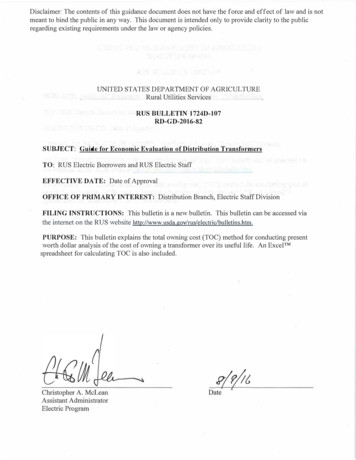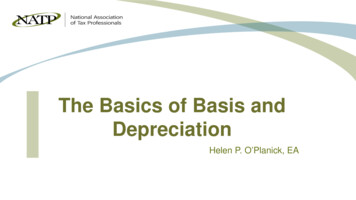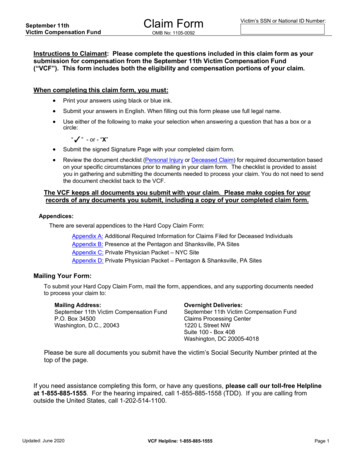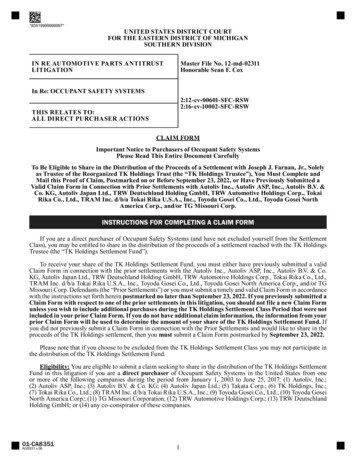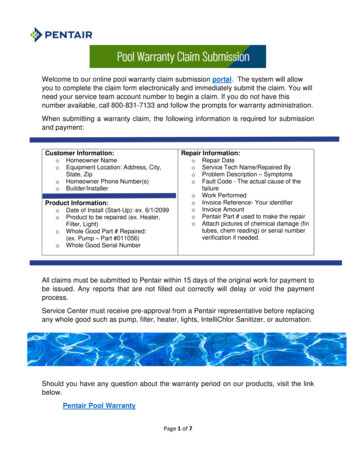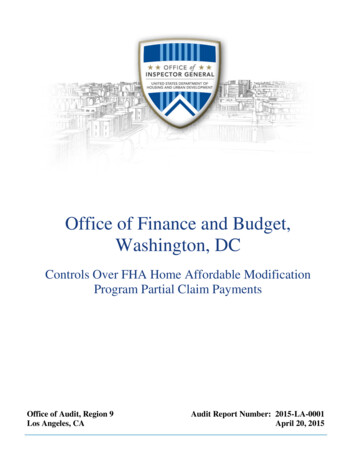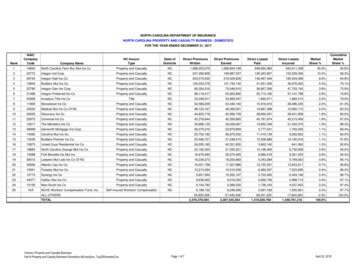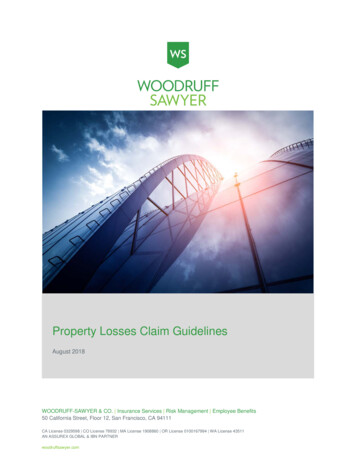
Transcription
Property Losses Claim GuidelinesAugust 2018WOODRUFF-SAWYER & CO. Insurance Services Risk Management Employee Benefits50 California Street, Floor 12, San Francisco, CA 94111CA License 0329598 CO License 78932 MA License 1908860 OR License 0100167994 WA License 43511AN ASSUREX GLOBAL & IBN PARTNERwoodruffsawyer.com
Table of ContentsProperty Losses Claim GuidelinesDocumenting Information for an Insurance Claim. 1Property Claims . 2Types & Definitions . 2Action - Response . 2Documentation . 3Very Useful Advance Planning . 3Recommended Guidelines for Vendors . 3Every Event is Unique . 5Contacts & Reporting . 5This material, including any attachments, is confidential and proprietary information of Woodruff-Sawyer & Co. Thetransmission or distribution of these materials to anyone not authorized by Woodruff-Sawyer & Co. to receive it isstrictly prohibited.Property Losses Claim GuidelinesCONFIDENTIAL AND PROPRIETARY1
Documenting Information for an InsuranceClaimIn anticipation that a property claim may need to be filed/reported to the insurance company pleaseprovide the following information:1. Date of Loss2. Specific Location of Loss [include Department Name and Cost Center]3. Description of the Incident/Event4. Restoration Company Involved, Y/N5. Extent of Damage to specified area (e.g. square footage)6. Photographs taken of damaged items/area7. Clean-up/Repair/Salary Expense Documentation (restoration company involved, contractors forrepairs, employee hours for clean-up, salaries of all personnel whose work duties & scheduleshave been affected)8. Itemized List of large ticket items damaged beyond repair9. Itemized List of Personal Property damaged (office equipment, office furniture, surgicalequipment)10. Other material information, related to the incident, that could impact the financial loss (Check withRisk Finance for property insurance deductible amount for specific location)IMPORTANT: Retain physical custody of damaged inventory for inspection by insurance adjusters-please do not throw anything away without first checking with Risk/Finance on the status of the insuranceclaim--perhaps identify a location where items/equipment will be sequestered.Your policy will respond for damage to owned property (NOTE: The lease provision at “Insurance” willaddress ownership and insurable interests obligations, and must be reviewed; not all leases are alike.The “Repairs and Maintenance” language of a lease is NOT the controlling language in a claim scenario).In General: As a landlord, ownership may/or may not include any tenant improvements, only landlordowned items or where you have a financial interest (some leases have the landlord owning and insuringeverything structural). Likewise, tenant’s should claim their structural tenant improvements and businesspersonal property on their own policy (owner/financial interest in TI’s depends on the lease terms andinsurance policy coverages). The tenant(s) should report their own losses to their respectiveinsurer(s) for their tenant improvements and contents, and we can review the leases for waiver ofsubrogation language. Coordination with your landlord/tenant: You may both utilize the samecontractors, but the scope of work and costs should be prepared in separate estimates (broken down bysuite, common area, etc., or it will really be difficult to separate out later and will delay the settlement.Property Losses Claim GuidelinesCONFIDENTIAL AND PROPRIETARY1
Property ClaimsTypes & DefinitionsTypes Direct physical damage to real and personal property (water from plumbing, fire, wind, hurricane,collapse, earthquake, theft, burglary, etc.) Loss of utilities, when caused by covered peril Business Income Loss , when caused by covered perilDefinitions Covered Peril – Cause of loss to which insurance applies Replacement Cost – Payment for the replacement of damaged property without any deduction forphysical depreciation Actual Cash Value – Replacement cost minus depreciation Insurable Interest – Interest in property that includes a financial gain or loss Subrogation – Transferring one’s right of recovery of a loss to another party Proximate Cause – The efficient cause of a loss without which the loss would not have occurred(does not need to be immediate)Action - ResponseProperty Staff Assess damage and mitigate loss›But preserve cause of loss scene or evidence (fire cause and origin scene) Engage remediation crew Instruct tenants›To notice their own property insurance carriers›As to remediation and reconstruction plans›As to what repairs will be the tenant’s responsibility Secure copies of leases, vendor contracts, prior construction invoices Compile reconstruction costs, rent abatements, and extra expenses Document›Photographs, statements, incident report, professional engineering or damage reportProperty Losses Claim GuidelinesCONFIDENTIAL AND PROPRIETARY2
Woodruff Sawyer Advice regarding immediate response Advice regarding submission to insurance company; notify insurer Advocate for applicable coverage Work with insurer on behalf of the property to submit loss documentation and loss valuationInsurance Adjuster Confirms insurance coverage Investigates, hires construction expert, estimates repair costs, scope, and claim value Calculates depreciation for Actual Cash Value settlement Calculates business income loss Submits settlement offer and paymentDocumentation Invoices of prior purchase, repair, or work Leases, contracts, civic directives or codes Photographs – Close range and wide angle Security or engineering reports For business income:›Profit and loss statements›Continuing and non-continuing expenses records›Rent rolls, abatements, extra expensesVery Useful Advance Planning Business continuity plan for a quick loss response Communication protocols And always – Protect the propertyThe most important thing to remember is to take whatever steps are necessary to protect the propertyfrom further damage immediately after an event. For example, this may include calls to plumbers,electricians, or window board-up companies for immediate emergency repairs. It’s not necessary to obtaininsurance company approval for immediate mitigation work. While the insurance company will review anddetermine whether the charges for such work are appropriate, it will not question their necessity.Recommended Guidelines for VendorsThe engineer, and the electrician or plumber, reports should be detailed and identify the cause of thefailure. The plumber/electrician estimate must be in a “line item” format, not lump sum values, it needs tohave a breakdown of costs for tear-in/access; costs of pipe/wiring materials; cost of labor forProperty Losses Claim GuidelinesCONFIDENTIAL AND PROPRIETARY3
pipe/wiring repairs; and cost of back-fill after the repairs, etc. Invoices for materials and timesheetsmay also be requested. If you request a breakdown in a Xactimate estimate (estimating software) orsimilar format, they usually accommodate. Most know what Xactimate is but you don’t see too manycontractors use if they don’t have a lot of insurance related work. Some contractors use “time andmaterials” estimates, and a request for the timesheets and materials invoices should be requested.All vendor estimates must be in a “line item” format, not lump sum values, as this will expedite theevaluation of the claim. Details of the measurements, grade of materials, material quantities, unitcosts, employee roles, labor hours worked, hourly rates, etc. are all needed in the estimate andinvoices. This should be requested upfront. If they don’t want to do it, you may want to consideranother contractor, since once the project is done they move on and it becomes harder to secure thedetails. If the general contractor uses sub-contractors, their invoices should be attached to the generalcontractor’s final bid and should be detailed as well. It will make the process easier and secure paymentfrom the insurer faster.Good samples of a “Line Item Estimate”: detailed descriptions, quantity, activity, rates, etc:Good sample of “Time and Materials” estimate: key parts highlighted and note level of detail (“ ½face” – yes, details matter):Property Losses Claim GuidelinesCONFIDENTIAL AND PROPRIETARY4
Here’s a bad sample – lacks the details for quantities, thickness of drywall, grade of tile (is it 10tiles or 10,000 tiles?), how many dumpsters of debris and what size dumpster, etc?Every Event is UniqueThis manual provides general guidelines for responding to various types of incidents, claims, and losses.Nevertheless, each event is unique as to the people and damages involved and each situation must beaddressed based on those specific circumstances. Therefore, do not hesitate to confer with management,emergency personnel, or the authorities (police/fire/medical) when responding to unusual, serious, orchallenging events.Contacts & ReportingImmediate Phone AssistanceEmanuel Enes (Property)Senior Claims ConsultantWoodruff Sawyereenes@woodruffsawyer.comP. 415.399.6372C. 408.892.5363Incident ReportsComplete as soon as possible, and forwarded to your Risk Manager and Woodruff Sawyer.Property Losses Claim GuidelinesCONFIDENTIAL AND PROPRIETARY5
› Photographs, statements, incident report, professional engineering or damage report : Property Losses Claim Guidelines CONFIDENTIAL AND PROPRIETARY 3 : Woodruff Sawyer Advice regarding immediate response . If you request a breakdown in a Xactimate estimate (estimating software) or similar format, they usually accommodate. Most know .



